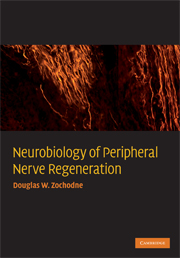Book contents
- Frontmatter
- Contents
- Acknowledgments
- 1 Introduction
- 2 The intact peripheral nerve tree
- 3 Injuries to peripheral nerves
- 4 Addressing nerve regeneration
- 5 Early regenerative events
- 6 Consolidation and maturation of regeneration
- 7 Regeneration and the vasa nervorum
- 8 Delayed reinnervation
- 9 Trophic factors and peripheral nerves
- 10 The nerve microenvironment
- References
- Index
- Plate section
- References
6 - Consolidation and maturation of regeneration
- Frontmatter
- Contents
- Acknowledgments
- 1 Introduction
- 2 The intact peripheral nerve tree
- 3 Injuries to peripheral nerves
- 4 Addressing nerve regeneration
- 5 Early regenerative events
- 6 Consolidation and maturation of regeneration
- 7 Regeneration and the vasa nervorum
- 8 Delayed reinnervation
- 9 Trophic factors and peripheral nerves
- 10 The nerve microenvironment
- References
- Index
- Plate section
- References
Summary
Regeneration is an ongoing process. Once axons form growth cones that cross injury zones, navigate distal stumps and approach former targets, they encounter additional challenges. The interaction of new axons with their targets involves a new series of events with new molecular requirements. Similarly axons are not fully effective the moment they reach their target. They must grow in caliber and may need to myelinate. This chapter will address these events.
Forming new nerve trunks after transection
After the transection of a nerve stump, the proximal and distal stump retract apart because they are normally under some degree of tension. Retraction leaves a gap. In some cases, the gap can be repaired by suturing nerve stumps together, but this is not always possible. Early studies successfully connected the stumps with conduits, tubes, or in one report, synovium propped open by a stainless steel spiral. Various surgical innovations are reviewed in more detail in other texts and sources [421,422,660,775]. They include nerve grafts, silicone tubes, vein–muscle conduits, fibronectin mats, veins, synthetic longitudinal filaments, collagen tubes, polymer biodegradable tubes, and others. With these strategies, eventual complete reconstitution of a severed new nerve trunk from the proximal to the distal stump can occur. This was initially described by Lundborg and colleagues [424–427].
When proximal and distal stumps are connected by tubes, an eventual connection therefore does develop as discussed in the previous chapter [610,740]. In the first week, extracellular exudative fluid and a fibrin matrix clot form within the tubes.
- Type
- Chapter
- Information
- Neurobiology of Peripheral Nerve Regeneration , pp. 133 - 152Publisher: Cambridge University PressPrint publication year: 2008



